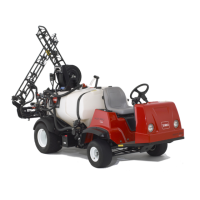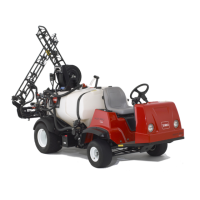Multi Pro 1200/1250Hydraulic System Page 4 -- 4
General Information
Operator’s Manual
The Operator’s Manual provides information regarding
the operation, general maintenance and maintenance
intervals for your Multi Pro machine. Refer to that publi-
cationforadditional information when servicingthema-
chine.
Relieving Hydraulic System Pressure
Beforedisconnecting orperformingany workonthehy-
draulic system, all pressure in the hydraulic system
mustberelieved.Park machine on alevelsurface,stop
engine and engage parking brake. Once all moving
parts have come to a complete stop, rotate steering
wheel in both directions to relieve hydraulic system
pressure.
Hydraulic Hoses
Hydraulichoses are subjecttoextreme conditionssuch
aspressuredifferentialsduringoperationandexposure
to weather, sun, chemicals, very warm storage condi-
tionsormishandlingduringoperationandmaintenance.
These conditions can cause hosedamage and deterio-
ration. Some hoses are more susceptible to these
conditions than others. Inspect all machine hydraulic
hoses frequently for signs of deterioration or damage:
Hard, cracked, cut, abraded, charred, leaking or
otherwise damaged hose.
Kinked, crushed, flattened or twisted hose.
Blistered, soft, degraded or loose hose cover.
Cracked, damaged or badly corroded hose fittings.
When replacing a hydraulic hose, be sure that the hose
is straight (not twisted) before tightening the fittings.
This can be done by observing the imprint (layline) on
the hose. Use two wrenches when tightening a hose;
hold the hose straight with one wrench and tighten the
hose swivel nut onto the fitting with the second wrench
(see Hydraulic Hose and Tube Installation in this sec-
tion). If the hose has an elbow at one end, tighten the
swivel nut on that end before tightening the nut on the
straight end of the hose.
For additional hydraulic hose information, refer to Toro
Service Training Book, Hydraulic Hose Servicing ( Part
Number 94813SL).
WARNING
Before disconnecting components or perform-
inganywork onhydraulicsystem,all pressurein
the system must be relieved by stopping the en-
gine and rotating the steering wheel in both
directions.
Keepbodyandhandsawayfrompinholeleaksor
nozzles that eject hydraulic fluid under high
pressure. Use paper or cardboard, not hands, to
search for leaks. Hydraulic fluid escaping under
pressure can have sufficient force to penetrate
the skin and cause serious injury. If fluid is in-
jected into the skin, it must be surgically re-
moved within a few hours by a doctor familiar
withthistypeofinjury.Gangrenemayresultfrom
such an injury.

